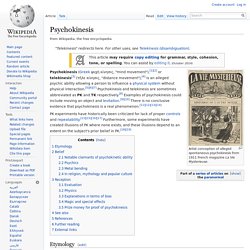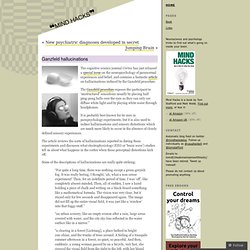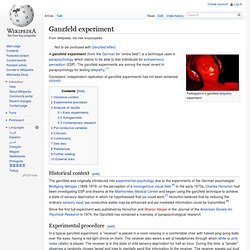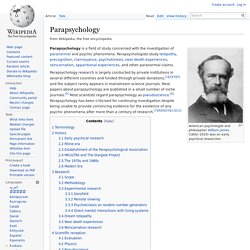

Psychokinesis. Artist conception of alleged spontaneous psychokinesis from 1911 French magazine La Vie Mysterieuse.

PK experiments have historically been criticized for lack of proper controls and repeatability.[13][15][16][17] Furthermore, some experiments have created illusions of PK where none exists, and these illusions depend to an extent on the subject's prior belief in PK.[18][19] Etymology[edit] The word psychokinesis, a portmanteau of the Greek language words ψυχή ("psyche"), meaning mind, soul, spirit, or breath; and κίνησις ("kinesis"), meaning motion, movement,[1][2] was coined in 1914 by American author Henry Holt in his book On the Cosmic Relations.[20][21][22] The term was later adopted by American parapsychologist J.
B. Rhine in 1934 in connection with experiments that were conducted to determine if a person could influence the outcome of falling dice.[8][23] Belief[edit] Notable claimants of psychokinetic ability[edit] There have been claimants of psychokinetic ability throughout history. Ganzfeld hallucinations. The cognitive science journal Cortex has just released a special issue on the neuropsychology of paranormal experiences and belief, and contains a fantastic article on hallucinations induced by the Ganzfeld procedure.

The Ganzfeld procedure exposes the participant to ‘unstructured’ sensations usually by placing half ping-pong balls over the eyes so they can only see diffuse white light and by playing white noise through headphones. It is probably best known for its uses in parapsychology experiments, but it is also used to induce hallucinations and sensory distortions which are much more likely to occur in the absence of clearly defined sensory experiences. The article reviews the sorts of hallucinations reported in during these experiments and discusses what electrophysiology (EEG or ‘brain wave’) studies tell us about what happens in the cortex when these perceptual distortions kick off.
Some of the descriptions of hallucinations are really quite striking: Link to Cortex special issue. Ganzfeld experiment. Participant in a ganzfeld telepathy experiment A ganzfeld experiment (from the German for “entire field”) is a technique used in parapsychology which claims to be able to test individuals for extrasensory perception (ESP).

The ganzfeld experiments are among the most recent in parapsychology for testing telepathy.[1] Consistent, independent replication of ganzfeld experiments has not been achieved.[2][3][4][5] Historical context[edit] Since the first full experiment was published by Honorton and Sharon Harper in the Journal of the American Society for Psychical Research in 1974, the Ganzfeld has remained a mainstay of parapsychological research.
Experimental procedure[edit] In a typical ganzfeld experiment, a "receiver" is placed in a room relaxing in a comfortable chair with halved ping-pong balls over the eyes, having a red light shone on them. Analysis of results[edit] Early experiments[edit] Autoganzfeld[edit] Ray Hyman in 1983 with Lee Ross, Daryl Bem and Victor Benassi. Criticism[edit] C. Parapsychology. American psychologist and philosopher William James (1842–1910) was an early psychical researcher.

Parapsychology is a field of study concerned with the investigation of paranormal and psychic phenomena. Parapsychologists study telepathy, precognition, clairvoyance, psychokinesis, near-death experiences, reincarnation, apparitional experiences, and other paranormal claims. Parapsychology research is largely conducted by private institutions in several different countries and funded through private donations,[1][2][3][4] and the subject rarely appears in mainstream science journals. Most papers about parapsychology are published in a small number of niche journals.[5] Most scientists regard parapsychology as pseudoscience.[6] Parapsychology has been criticised for continuing investigation despite being unable to provide convincing evidence for the existence of any psychic phenomena after more than a century of research.[7][8][9][10][11][12]